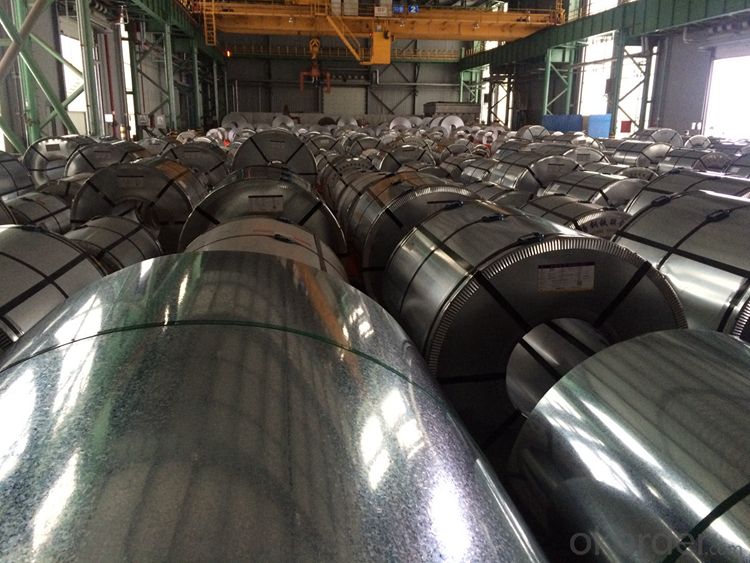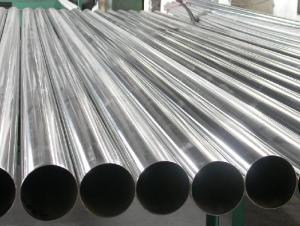Hot Dip Galvanized Steel Coil Galvanized Sheet In Coil
- Loading Port:
- Tianjin
- Payment Terms:
- TT OR LC
- Min Order Qty:
- 50 m.t.
- Supply Capability:
- 20000 m.t./month
OKorder Service Pledge
OKorder Financial Service
You Might Also Like
Specification
DESCRIPTION FOR GALVANIZED STEEL COILS:
Mian Quality Standard | JIS G3302, EN10346, DIN17162, ASTM A653/653M, GB2518 |
Process | hot dip galvanizing |
Process Speed | 1#. Max 120m/min, 2#. Max 130m/min |
Thickness | 1#. 0.25mm upto 1.20mm, 2#. 0.25mm upto 1.0mm |
Width | 900mm upto 1300mm |
Surface Finish | zero spangles, skinpassed, oiled,chromated, tension level, |
Coating | zinc layer mass on both sides from 30 g/m2 upto 180g/m2 |
Yield Strength | 220Mpa upto 750Mpa |
Weight per Coil | max 15,000kg |
Inner Diameter | φ 508mm |
Outer Diameter | max φ 2,050mm |
Finished Internal Diameter | Φ 508mm or φ 610mm |
Finished Coil Weight | 1#. max 10,000kg, 2#. max 15,000kg |
Packing | Mill's Export Standard Packing |
Capacity | 300,000 tons/year |
EXPORT STANDARD FOR GALVANIZED STEEL COILS:
-Axial and circumferential steel straps with seal (4 steel straps each)
-VCI Anti-rust kraft paper
-Water-proofing plastic
-Pearl wool (coil surface)
-Steel cover (coil surface/bore)
-Plastic cover (coil sides)
-Inside and outside corner protectors
Or According customers' requirements(Usually only for domestic)
PACKAGING &DELIVERY FOR GALVANIZED STEEL COILS:
Packaging Detail Standard export packing or following customer's demand
Delivery Time: Within 30-40 days after deposit or according to the order quantity
PACKAGING &DELIVERY FOR GALVANIZED STEEL COILS:
1.Big thickness:by bulk vessel
2.Small thickness:packed by steel strips and shipped by container
3.According to the requirements of customers'
TRADE TERMS FOR GALVANIZED STEEL COILS:FOB, CFR, CIF
DETAILED PICTURES FOR GALVANIZED STEEL COILS:


APPLICATION FOR GALVANIZED STEEL COILS:
Galvanized steel products are mainly used in construction, light industry, automobile, agriculture , fishery and commercial industries. They have great advantages:1.it has small harm to the environment and it can be recycled, greatly lighten the stress to the environment.2.it is convenient to process,easy to construct and has good waterproof effect.
FAQ FOR GALVANIZED STEEL COILS:
Q:Do you have OEM service?
A: Yes.Variety of products size,quality and quantity can be customized according to your need.
Q:Could you support free sample?
A:Yes.We can supply FREE samples.But the delivery charges will be covered by our customers.
- Q: What is the maximum temperature that stainless steel sheets can withstand?
- The maximum temperature that stainless steel sheets can withstand depends on the specific grade or alloy of stainless steel being used. However, most stainless steel sheets can typically withstand temperatures of up to around 1500 degrees Fahrenheit (815 degrees Celsius) before experiencing significant structural or mechanical changes.
- Q: What's the price of 06cr19ni10 and 304 stainless steel?
- In order to maintain the inherent corrosion resistance of stainless steel, steel must contain more than 16% chromium, more than 8% of the nickel content. 304 stainless steel is a brand of stainless steel produced according to the ASTM standard in the United states.
- Q: Are stainless steel sheets suitable for medical implants?
- Yes, stainless steel sheets are suitable for medical implants. Stainless steel is commonly used in medical implants due to its excellent corrosion resistance, mechanical strength, and biocompatibility. It can be easily sterilized, is durable, and has a long track record of successful use in various medical applications.
- Q: Are stainless steel sheets good for pressure vessels?
- Stainless steel sheets have gained popularity as a preferred choice for pressure vessels due to their durability, reliability, and ability to meet the demanding requirements of such applications. Commonly employed, they are considered to be an excellent option. Stainless steel possesses exceptional resistance to corrosion, high strength, and commendable mechanical properties, rendering it suitable for applications that necessitate withstanding high pressures. Moreover, stainless steel exhibits remarkable heat resistance, a pivotal trait in pressure vessels where exposure to elevated temperatures is likely. It is also important to highlight that stainless steel lends itself to easy formation and welding, facilitating the fabrication of intricate shapes and designs required for pressure vessel construction. All in all, stainless steel sheets are a favored material for pressure vessels due to their ability to endure, their dependability, and their capacity to fulfill the demanding prerequisites of such applications.
- Q: Can stainless steel sheets be used for exterior cladding?
- Indeed, exterior cladding can utilize stainless steel sheets. The robustness and resistance to corrosion of stainless steel make it appropriate for various purposes, including cladding. Stainless steel sheets present exceptional endurance against weathering, UV rays, and extreme temperatures, rendering them perfect for external usage. They can endure severe environmental conditions, such as heavy rain, snow, and strong winds, without deteriorating or losing their aesthetic charm. Moreover, stainless steel sheets are available in an extensive array of finishes, allowing for customization and design adaptability. Whether for residential, commercial, or industrial edifices, stainless steel cladding offers a durable and visually pleasing solution.
- Q: What is the maximum size of stainless steel sheets?
- The size of stainless steel sheets can differ based on the manufacturer and customer requirements. Generally, standard sizes for stainless steel sheets range from 4 feet by 8 feet (1.2 meters by 2.4 meters) to 5 feet by 10 feet (1.5 meters by 3 meters). Although some manufacturers may offer larger sizes like 6 feet by 12 feet (1.8 meters by 3.7 meters), these are rare and may need special ordering. It is important to note that custom sizes can be created by cutting or welding multiple sheets together, enabling larger dimensions if necessary.
- Q: What are stainless steel sheets?
- Stainless steel sheets are flat metal plates made from an alloy of iron, chromium, and other elements that prevent corrosion and rusting. They are commonly used in various industries such as construction, automotive, and manufacturing, due to their durability, strength, and resistance to staining and oxidation.
- Q: Are stainless steel sheets suitable for nuclear power plants?
- Stainless steel sheets are well-suited for nuclear power plants due to their unique properties that make them ideal for such hazardous environments. Firstly, their exceptional corrosion resistance is crucial in plants with high levels of corrosive substances. Corrosion can compromise materials' structural integrity, leading to safety risks and potential failures. Therefore, stainless steel's resistance to corrosion ensures the longevity and reliability of equipment and structures in nuclear power plants. Secondly, stainless steel possesses high strength and toughness, enabling it to withstand extreme conditions like high temperatures and pressures found in these facilities. This strength and toughness allow stainless steel to endure the harsh environment and potential mechanical stresses that may arise during normal operations or accidents. Moreover, stainless steel exhibits excellent heat resistance, a critical characteristic in nuclear power plants where nuclear fission generates high temperatures. Stainless steel's ability to maintain its strength and structural integrity even at elevated temperatures makes it suitable for containing and handling radioactive materials and hot fluids. Additionally, stainless steel is easy to clean and maintain, which is vital in nuclear power plants where cleanliness and sterility are paramount. Regular cleaning and maintenance are necessary to prevent the accumulation of radioactive contaminants and ensure the safe and efficient operation of equipment and systems. In conclusion, stainless steel sheets are highly suitable for use in nuclear power plants due to their corrosion resistance, strength, toughness, heat resistance, and ease of maintenance. Their utilization ensures the safety, reliability, and durability of equipment and structures, thereby enhancing the overall efficiency and effectiveness of nuclear power plants.
- Q: What is the maximum width available for stainless steel sheets?
- The stainless steel sheet's maximum width can differ based on the manufacturer and supplier. Typically, you can find stainless steel sheets with widths between 36 inches (0.91 meters) and 72 inches (1.83 meters). Certain manufacturers may provide wider options for specialized purposes. To ensure accuracy, it's recommended to consult the specific supplier or manufacturer regarding the maximum width as it may vary depending on their production capabilities and product range.
- Q: Can stainless steel sheets be used in the automotive industry?
- Yes, stainless steel sheets can be used in the automotive industry. Stainless steel is often used due to its high strength, corrosion resistance, and durability. It is used for various components such as exhaust systems, body panels, frames, and interior trim.
Send your message to us
Hot Dip Galvanized Steel Coil Galvanized Sheet In Coil
- Loading Port:
- Tianjin
- Payment Terms:
- TT OR LC
- Min Order Qty:
- 50 m.t.
- Supply Capability:
- 20000 m.t./month
OKorder Service Pledge
OKorder Financial Service
Similar products
Hot products
Hot Searches
Related keywords
































